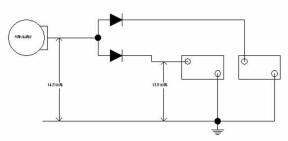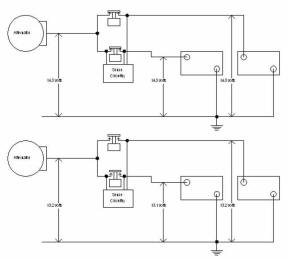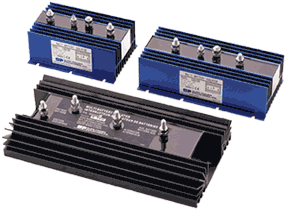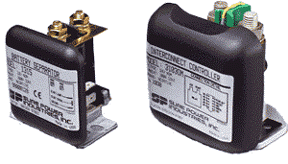 |
 |
 |
Last Changed 2/11/2007
|
The ideal situation is to charge the trailer battery from the tow
vehicle while it is connected. But you want to protect the tow
vehicle battery when the trailer is connected to the tow vehicle
when it is not running. You need some kind of battery isolation.
If there is not isolation between the batteries, when the alternator
is not producing current, the battery with lower voltage will draw
current from the other battery and eventually drain both batteries.
|
 |
|
click on image to enlarge |
| A diode isolator, generally called Battery Isolator, is made with
high powered diodes mounted on a heat sink. The one-way
current flow of the diode allows current from the alternator to flow
to the batteries but prevents current flow in the opposite
direction. |
The problem with diode isolation is that the diode has an amount
of internal resistance. That resistance, with the current flow
through the diode cause a 0.7 volt drop across the diode. In
the example, 14.5 volts on the input to the diode has 13.8 volts on
the output. |
The alternator's regulator will allow voltage to build until around
14.5 volts. At this point, the alternator's regulator believes the
battery is charged. Unfortunately, the battery is only at 13.8
volts because of the diode voltage drop and is not fully charged.
Thus the diode isolator will keep one battery from draining the
other but will not allow the batteries to fully charge.
In the marine world, there are special regulators designed for the
marine alternators to allow the alternator to over-charge until the
batteries top off. However, these alternator are not fit for the
type of trucks we are looking at.
|
 |
|
click on image to enlarge |
Electronic battery isolators, generally called Battery Combiners but
are know by other names, provide battery isolation without the
voltage loss. There are sense circuits that measure the voltage of
the input and outputs of the Combiner. These sense circuits control
solenoid driven contacts that connect the batteries when closed.
Depending on the voltage, the sense circuit will open or close the
solenoid. Generally the circuit closes at 13.3 volts. However, the
sense circuits compare both sides of the solenoid contacts. In the
upper example circuit, the alternator is producing more than 13.3
volts and therefore the contacts are closed and the batteries
receive current. The alternator will charge to 14.5 volts and the
batteries will receive 14.5 volts topping them off. |
With the alternator not producing enough voltage as in the lower
example, the contacts will remain closed until the input voltage
drops below 13.3 volts. Thus the battery can feed another as long
as the feeding battery is above 13.3 volts. Once the voltage drops
below 13.3 volts, the contacts open and the batteries are isolated
from each other.
Battery Combiners cost more than Battery Isolators but they are
superior in charging the batteries.
|
click on image to enlarge |
 |
|
click on image to enlarge |
These are Battery Isolators from Sure Power. |
 |
|
|
These are Battery Combiners from Sure Power. In Sure Power terminology, they are called Smart Charge Battery Separators. |
 |
|
|
These are Battery Combiners from West Marine. |

